Play audio — original link
Play audio
Play audio

REGULAR MEETING OF THE HIV PLANNING COUNCIL EXECUTIVE COMMITTEE MEETING TUESDAY, JULY 2, 2024, 5:00 P.M. PERMITTING AND DEVELOPMENT CENTER 6310 WILHELMINA DELCO DRIVE, RM. 1203 AUSTIN, TEXAS Some members of the HIV PLANNING COUNCIL may be participating by videoconference. The meeting may be viewed online at: Click here to join the meeting Public comment will be allowed online via Teams or remotely via telephone. Speakers may only register to speak on an item once either online or remotely and will be allowed up to three minutes to provide their comments. Registration no later than noon the day before the meeting is required for remote participation by telephone. To register to speak remotely, call or email the Office of Support, (737)-825-1684, hivplanningcouncil@austintexas.gov CURRENT HIV PLANNING COUNCIL EXECUTIVE COMMITTEE MEMBERS: Kelle’ Martin, Chair Marquis Goodwin, Vice-Chair, conflicted Zachery Garay, GMCS Committee Chair, conflicted Ashley Garling, FASPNA Committee Chair Kristina McRae-Thompson AGENDA CALL TO ORDER PUBLIC COMMUNICATION: GENERAL The first 10 speakers signed up no later than noon on 7/1/2024 will each be allowed a three- minute allotment to address their concerns regarding items not posted on the agenda. APPROVAL OF MINUTES 1. June 4, 2024 CONFLICT OF INTEREST DECLARATIONS 2. Members will declare conflict of interest with relevant agenda items, service categories, and/or service standards. STAFF BRIEFINGS 3. Introductions/Announcements 4. Office of Support Staff Report 5. Administrative Agent Report DISCUSSION AND ACTION ITEMS 7. Discussion of Internal Review COMMITTEE UPDATES FUTURE AGENDA ITEMS 10. Discussion of Workplan calendar ADJOURNMENT Indicative of action items 6. Discussion and approval of Secretary Nominations 8. Governance/Membership and Care Strategies Committee 9. Finance/Allocations and Strategic Planning/Needs Assessment Committee The City of Austin is committed to compliance with the American with Disabilities Act. Reasonable modifications and equal access to communications will be provided upon request. Meeting locations are planned with wheelchair access. If requiring Sign Language Interpreters or alternative formats, please give notice at least 2 days (48 hours) before the meeting date. TTY users’ route through Relay Texas at 711. For More Information on the HIV Planning Council, please contact Nathalia Delgadillo at (512) 972-5841.
Play audio
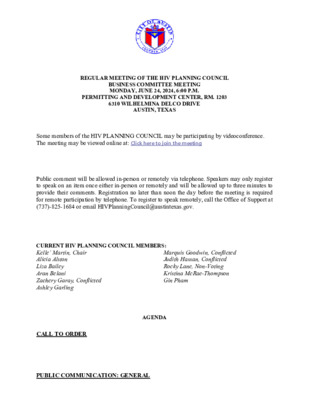
REGULAR MEETING OF THE HIV PLANNING COUNCIL BUSINESS COMMITTEE MEETING MONDAY, JUNE 24, 2024, 6:00 P.M. PERMITTING AND DEVELOPMENT CENTER, RM. 1203 6310 WILHELMINA DELCO DRIVE AUSTIN, TEXAS Some members of the HIV PLANNING COUNCIL may be participating by videoconference. The meeting may be viewed online at: Click here to join the meeting Public comment will be allowed in-person or remotely via telephone. Speakers may only register to speak on an item once either in-person or remotely and will be allowed up to three minutes to provide their comments. Registration no later than noon the day before the meeting is required for remote participation by telephone. To register to speak remotely, call the Office of Support at (737)-825-1684 or email HIVPlanningCouncil@austintexas.gov. CURRENT HIV PLANNING COUNCIL MEMBERS: Kelle’ Martin, Chair Alicia Alston Liza Bailey Aran Belani Zachery Garay, Conflicted Ashley Garling AGENDA CALL TO ORDER Marquis Goodwin, Conflicted Judith Hassan, Conflicted Rocky Lane, Non-Voting Kristina McRae-Thompson Gin Pham PUBLIC COMMUNICATION: GENERAL The first 10 speakers signed up no later than noon on 6/24/2024 will each be allowed a three- minute allotment to address their concerns regarding items not posted on the agenda. APPROVAL OF MINUTES 2. Members will declare conflicts of interest with relevant agenda items, service categories, 1. May 20, 2024 CONFLICT OF INTEREST DECLARATIONS and/or service standards. STAFF BRIEFINGS 3. Introductions/Announcements 4. Office of Support Staff Report 5. Administrative Agent Report 6. Part B Report DISCUSSION AND ACTION ITEMS 7. Presentation of Fast Track Cities and Ending the HIV Epidemic Updates 8. Discussion and approval of new member applicant 9. Discussion and approval of Townhall Flyer and Agenda 10. Discussion and approval of FAQ Flyer 11. Discussion of Notice of Award for Fiscal Year 2024 (FY24) 12. Discussion and approval of Policies and Procedures, Memorandum of Understanding 13. Discussion of the Annual Internal Review and Report of the HIV Planning Council (MOU), and Bylaws 14. Open nominations for Secretary COMMITTEE UPDATES 15. Governance/Membership and Care Strategies 16. Finance/Allocations and Strategic Planning/Needs Assessment FUTURE AGENDA ITEMS 17. Review of workplan calendar and social calendar ADJOURNMENT Indicative of action items The City of Austin is committed to compliance with the American with Disabilities Act. Reasonable modifications and equal access to communications will be provided upon request. Meeting locations are planned with wheelchair access. If requiring Sign Language Interpreters or alternative formats, please give notice at least 2 days (48 hours) before …
Play audio
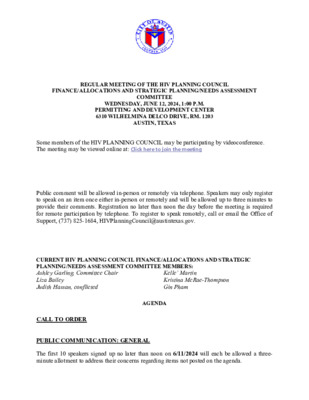
REGULAR MEETING OF THE HIV PLANNING COUNCIL FINANCE/ALLOCATIONS AND STRATEGIC PLANNING/NEEDS ASSESSMENT COMMITTEE WEDNESDAY, JUNE 12, 2024, 1:00 P.M. PERMITTING AND DEVELOPMENT CENTER 6310 WILHELMINA DELCO DRIVE, RM. 1203 AUSTIN, TEXAS Some members of the HIV PLANNING COUNCIL may be participating by videoconference. The meeting may be viewed online at: Click here to join the meeting Public comment will be allowed in-person or remotely via telephone. Speakers may only register to speak on an item once either in-person or remotely and will be allowed up to three minutes to provide their comments. Registration no later than noon the day before the meeting is required for remote participation by telephone. To register to speak remotely, call or email the Office of Support, (737) 825-1684, HIVPlanningCouncil@austintexas.gov. CURRENT HIV PLANNING COUNCIL FINANCE/ALLOCATIONS AND STRATEGIC PLANNING/NEEDS ASSESSMENT COMMITTEE MEMBERS: Ashley Garling, Committee Chair Kelle’ Martin Liza Bailey Kristina McRae-Thompson Judith Hassan, conflicted Gin Pham AGENDA CALL TO ORDER PUBLIC COMMUNICATION: GENERAL The first 10 speakers signed up no later than noon on 6/11/2024 will each be allowed a three- minute allotment to address their concerns regarding items not posted on the agenda. APPROVAL OF MINUTES 1. May 8, 2024 and/or service standards. STAFF BRIEFINGS 3. Introductions/Announcements 4. Office of Support staff report CONFLICT OF INTEREST DECLARATIONS 2. Members will declare conflict of interest with relevant agenda items, service categories, 5. Administrative Agent Expenditures Report DISCUSSION AND ACTION ITEMS 6. Discussion of the Fiscal Year (FY) 2024 Notice of Award 7. Discussion of FY23 Part A Expenditures 8. Discussion and approval of Minority AIDS Initiative (MAI) and Early Identification of Individuals with HIV/AIDS (EIIHA) data review with recommendation of service category priorities 9. Discussion and approval of Integrated Plan Updates FUTURE AGENDA ITEMS 10. Workplan Calendar review ADJOURNMENT Indicative of action items The City of Austin is committed to compliance with the American with Disabilities Act. Reasonable modifications and equal access to communications will be provided upon request. Meeting locations are planned with wheelchair access. If requiring Sign Language Interpreters or alternative formats, please give notice at least 2 days (48 hours) before the meeting date. TTY users’ route through Relay Texas at 711. For More Information on the HIV Planning Council, please contact HIV Planning Council Office of Support at (737) 825-1684.
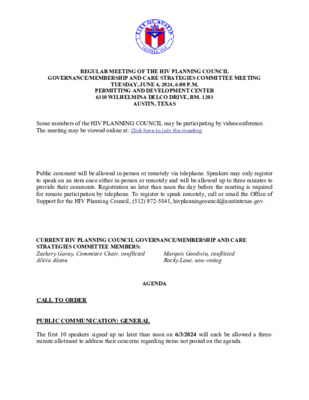
REGULAR MEETING OF THE HIV PLANNING COUNCIL GOVERNANCE/MEMBERSHIP AND CARE STRATEGIES COMMITTEE MEETING TUESDAY, JUNE 4, 2024, 6:00 P.M. PERMITTING AND DEVELOPMENT CENTER 6310 WILHELMINA DELCO DRIVE, RM. 1203 AUSTIN, TEXAS Some members of the HIV PLANNING COUNCIL may be participating by videoconference. The meeting may be viewed online at: Click here to join the meeting Public comment will be allowed in-person or remotely via telephone. Speakers may only register to speak on an item once either in-person or remotely and will be allowed up to three minutes to provide their comments. Registration no later than noon the day before the meeting is required for remote participation by telephone. To register to speak remotely, call or email the Office of Support for the HIV Planning Council, (512) 972-5841, hivplanningcouncil@austintexas.gov. CURRENT HIV PLANNING COUNCIL GOVERNANCE/MEMBERSHIP AND CARE STRATEGIES COMMITTEE MEMBERS: Zachery Garay, Committee Chair, conflicted Alicia Alston Marquis Goodwin, conflicted Rocky Lane, non-voting AGENDA CALL TO ORDER PUBLIC COMMUNICATION: GENERAL The first 10 speakers signed up no later than noon on 6/3/2024 will each be allowed a three- minute allotment to address their concerns regarding items not posted on the agenda. 2. Members will declare conflict of interest with relevant agenda items, service categories, APPROVAL OF MINUTES 1. May 7, 2024 CONFLICT OF INTEREST DECLARATIONS and/or service standards. STAFF BRIEFINGS 3. Introductions/Announcements 4. Office of Support Staff Report DISCUSSION AND ACTION ITEMS 5. Interview of HIV Planning Council Applicant(s) 6. Discussion and approval of HIV Planning Council Applicant 7. Discussion and approval of Non-voting Member 8. Discussion and approval of Meeting Time and Day 9. Discussion and approval of Townhall Documents 10. Discussion and approval of Current Directives 11. Discussion and approval of Potential Directives Website Updates 13. Office of Support Membership Report 14. Office of Support Attendance Report FUTURE AGENDA ITEMS 15. Discussion and review of workplan and social calendar 12. Discussion and approval of Recruitment and Retention Plan: Marketing Materials and ADJOURNMENT Indicative of action items The City of Austin is committed to compliance with the American with Disabilities Act. Reasonable modifications and equal access to communications will be provided upon request. Meeting locations are planned with wheelchair access. If requiring Sign Language Interpreters or alternative formats, please give notice at least 2 days (48 hours) before the meeting date. TTY users’ route through Relay Texas at 711. For More Information on the HIV Planning Council, please contact Nathalia …
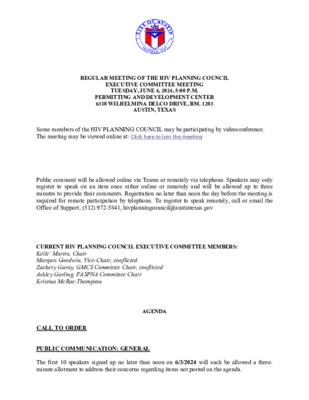
REGULAR MEETING OF THE HIV PLANNING COUNCIL EXECUTIVE COMMITTEE MEETING TUESDAY, JUNE 4, 2024, 5:00 P.M. PERMITTING AND DEVELOPMENT CENTER 6310 WILHELMINA DELCO DRIVE, RM. 1203 AUSTIN, TEXAS Some members of the HIV PLANNING COUNCIL may be participating by videoconference. The meeting may be viewed online at: Click here to join the meeting Public comment will be allowed online via Teams or remotely via telephone. Speakers may only register to speak on an item once either online or remotely and will be allowed up to three minutes to provide their comments. Registration no later than noon the day before the meeting is required for remote participation by telephone. To register to speak remotely, call or email the Office of Support, (512) 972-5841, hivplanningcouncil@austintexas.gov CURRENT HIV PLANNING COUNCIL EXECUTIVE COMMITTEE MEMBERS: Kelle’ Martin, Chair Marquis Goodwin, Vice-Chair, conflicted Zachery Garay, GMCS Committee Chair, conflicted Ashley Garling, FASPNA Committee Chair Kristina McRae-Thompson AGENDA CALL TO ORDER PUBLIC COMMUNICATION: GENERAL The first 10 speakers signed up no later than noon on 6/3/2024 will each be allowed a three- minute allotment to address their concerns regarding items not posted on the agenda. APPROVAL OF MINUTES 1. May 7, 2024 CONFLICT OF INTEREST DECLARATIONS and/or service standards. STAFF BRIEFINGS 3. Introductions/Announcements 4. Office of Support Staff Report 5. Administrative Agent Report DISCUSSION AND ACTION ITEMS 2. Members will declare conflict of interest with relevant agenda items, service categories, 6. Discussion and approval of Policies and Procedures 7. Discussion and approval of the Memorandum of Understanding (MOU) 8. Discussion and approval of Bylaws edits COMMITTEE UPDATES 9. Governance/Membership and Care Strategies Committee 10. Finance/Allocations and Strategic Planning/Needs Assessment Committee FUTURE AGENDA ITEMS 11. Discussion of Workplan calendar ADJOURNMENT Indicative of action items The City of Austin is committed to compliance with the American with Disabilities Act. Reasonable modifications and equal access to communications will be provided upon request. Meeting locations are planned with wheelchair access. If requiring Sign Language Interpreters or alternative formats, please give notice at least 2 days (48 hours) before the meeting date. TTY users’ route through Relay Texas at 711. For More Information on the HIV Planning Council, please contact Nathalia Delgadillo at (512) 972-5841.
Play audio
Play audio
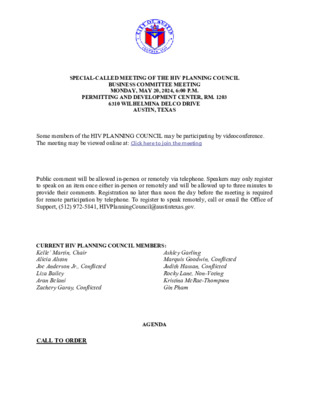
SPECIAL-CALLED MEETING OF THE HIV PLANNING COUNCIL BUSINESS COMMITTEE MEETING MONDAY, MAY 20, 2024, 6:00 P.M. PERMITTING AND DEVELOPMENT CENTER, RM. 1203 6310 WILHELMINA DELCO DRIVE AUSTIN, TEXAS Some members of the HIV PLANNING COUNCIL may be participating by videoconference. The meeting may be viewed online at: Click here to join the meeting Public comment will be allowed in-person or remotely via telephone. Speakers may only register to speak on an item once either in-person or remotely and will be allowed up to three minutes to provide their comments. Registration no later than noon the day before the meeting is required for remote participation by telephone. To register to speak remotely, call or email the Office of Support, (512) 972-5841, HIVPlanningCouncil@austintexas.gov. CURRENT HIV PLANNING COUNCIL MEMBERS: Kelle’ Martin, Chair Alicia Alston Joe Anderson Jr., Conflicted Liza Bailey Aran Belani Zachery Garay, Conflicted AGENDA CALL TO ORDER Ashley Garling Marquis Goodwin, Conflicted Judith Hassan, Conflicted Rocky Lane, Non-Voting Kristina McRae-Thompson Gin Pham PUBLIC COMMUNICATION: GENERAL The first 10 speakers signed up no later than noon on 5/19/2024 will each be allowed a three- minute allotment to address their concerns regarding items not posted on the agenda. APPROVAL OF MINUTES 1. April 22, 2024 CONFLICT OF INTEREST DECLARATIONS 2. Members will declare conflict of interest with relevant agenda items, service categories, and/or service standards. STAFF BRIEFINGS 3. Introductions/Announcements 4. Office of Support Staff Report 5. Administrative Agent Report 6. Part B Report DISCUSSION AND ACTION ITEMS 7. Presentation of Epidemiological Data from Flor Hernandez 8. Discussion and approval of Vice-Chair Nomination 9. Discussion and approval of Priority Setting and Resource Allocation Data (PSRA) Request 10. Discussion and approval of Integrated Plan updates 11. Discussion and approval of Needs Assessment Year 2 Topic 12. Discussion and approval of Town Hall Date, Time and Location and Goal 13. Discussion of National Latinx Conference Highlights COMMITTEE UPDATES 14. Governance/Membership and Care Strategies 15. Finance/Allocations and Strategic Planning/Needs Assessment FUTURE AGENDA ITEMS 16. Review of workplan calendar and social calendar ADJOURNMENT Indicative of action items The City of Austin is committed to compliance with the American with Disabilities Act. Reasonable modifications and equal access to communications will be provided upon request. Meeting locations are planned with wheelchair access. If requiring Sign Language Interpreters or alternative formats, please give notice at least 2 days (48 hours) before the meeting date. TTY users’ route through Relay Texas at …
Play audio
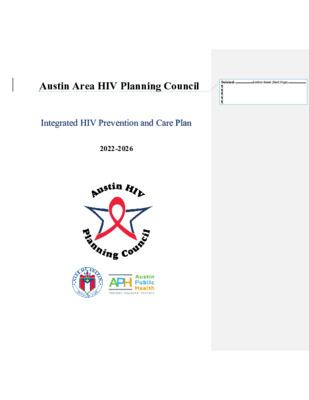
Austin Area HIV Planning Council Section Break (Next Page) Deleted: ¶ ¶ ¶ ¶ ¶ Integrated HIV Prevention and Care Plan 2022-2026 Table of Contents Page # SECTION I: EXECUTIVE SUMMARY OF INTEGRATED PLAN AND SCSN ............... 3 SECTION II: COMMUNITY ENGAGEMENT AND PLANNING PROCESS 1. JURISDICTIONAL PLANNING PROCESS ............................................................... 4 SECTION III: CONTRIBUTING DATA SETS AND ASSESSMENTS 1. DATA SHARING AND USE ........................................................................................... 7 2. EPIDEMIOLOGIC SNAPSHOT .................................................................................... 8 3. HIV PREVENTION CARE AND TREATMENT RESOURCE INVENTORY ...... 17 4. NEEDS ASSESSMENT .................................................................................................. 18 SECTION IV: SITUATIONAL ANALYSIS............................................................................ 18 SECTION V: 2022-2026 GOALS AND OBJECTIVES .......................................................... 18 SECTION VI: 2022-2026 INTEGRATED PLANNING IMPLEMENTATION APPROACH ............................................................................................................................... 19 SECTION VI: LETTERS OF CONCURRENCE 2 SECTION I. EXECUTIVE SUMMARY OF INTEGRATED PLAN AND SCSN The Integrated HIV Prevention and Care Plan is a five year plan to accelerate progress in the Austin Transitional Grant Area (TGA) towards diagnosing all people with HIV early as a possible, treating people with HIV rapidly and effectively to reach sustained viral suppression, preventing new HIV transmissions by using proven interventions, including pre-exposure prophylaxis (PrEP), and responding quickly to potential HIV outbreaks to get vital prevention and treatment services to people who need them in order to increase access to care, improve health outcomes, and reduce HIV-related health disparities. This plan reviews the landscape of the HIV epidemic in the Austin TGA—the demographics of those living with and more likely to be impacted by HIV/AIDS, resources and services available, and needs, gaps and barriers to prevention and care. The second half of the plan details goals and objectives the Austin TGA in accordance with the plans of our partners initiatives Ending the HIV Epidemic and Fast Track Cities. In 2019, there were 6,721 people living with HIV/AIDS (PWH) within the five county TGA, with over 100 new diagnoses that year. A majority (85%) of people with HIV are male. Among males, Whites have a higher prevalence at 42%, followed by Latinx at 36%. Black females comprise 48% of all females with HIV, while Black males comprise 16% of all males with HIV. Men who have sex with men (MSM) continue to bear a heavy burden of HIV in the Austin TGA. Table D demonstrates the distribution of mode of transmission by race/ethnicity among persons living with HIV in the Austin TGA. The most common mode of transmission was MSM (70%) for all races/ethnicities. MSM was the most …
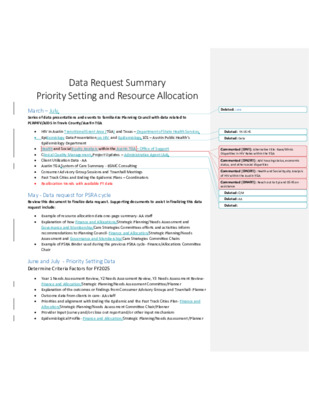
Data Request Summary Priority Setting and Resource Allocation March – July Series of data presentations and events to familiarize Planning Council with data related to PLWHIV/AIDS in Travis County/Austin TGA Deleted: June • HIV in Austin Transitional Grant Area (TGA) and Texas – Department of State Health Services • Epidemiology Data Presentation on HIV and Epidemiology 101 – Austin Public Health’s Deleted: TX DSHS Deleted: Data Epidemiology Department • Health and Social Equity Analysis within the Austin TGA – Office of Support • Clinical Quality Management Project Updates – Administrative Agent (AA) • Client Utilization Data - AA • Austin TGA System of Care Summary - EGMC Consulting • Consumer Advisory Group Sessions and Townhall Meetings • Fast Track Cities and Ending the Epidemic Plans – Coordinators • Reallocation trends with available FY data Commented [DN1]: Alternative title: Race/Ethnic Disparities in HIV Rates within the TGA Commented [DN2R1]: Add housing status, economic status, and other social disparities Commented [DN3R1]: Health and Social Equity Analysis of HIV within the Austin TGA Commented [DN4R1]: Reach out to Epi and DSHS on assistance May - Data request for PSRA cycle Review this document to finalize data request. Supporting documents to assist in finalizing this data request include: Deleted: QM Deleted: AA Deleted: • Example of resource allocation data one-page summary- AA staff • Explanation of how Finance and Allocations/Strategic Planning/Needs Assessment and Governance and Membership/Care Strategies Committees efforts and activities inform recommendations to Planning Council- Finance and Allocation/Strategic Planning/Needs Assessment and Governance and Membership/Care Strategies Committee Chairs • Example of PSRA Binder used during the previous PSRA cycle- Finance/Allocations Committee Chair June and July - Priority Setting Data Determine Criteria Factors for FY2025 • Year 1 Needs Assessment Review, Y2 Needs Assessment Review, Y3 Needs Assessment Review- Finance and Allocation/Strategic Planning/Needs Assessment Committee/Planner • Explanation of the outcomes or findings from Consumer Advisory Groups and Townhall- Planner • Outcome data from clients in care- AA staff • Priorities and alignment with Ending the Epidemic and the Fast Track Cities Plan- Finance and Allocation/Strategic Planning/Needs Assessment Committee Chair/Planner • Provider Input (survey and/or close out report and/or other input mechanism • Epidemiological Profile- Finance and Allocation/Strategic Planning/Needs Assessment /Planner • Relevant updates from FY23 • • Service Categories and Service Standard that Support Directives List of service categories that support early identification of people living with HIV Deleted: 2 July - Resource Allocation Data …
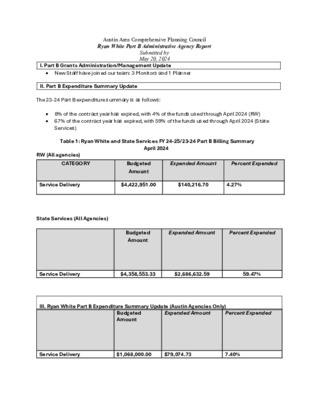
Austin Area Comprehensive Planning Council Ryan White Part B Administrative Agency Report Submitted by May 20, 2024 I. Part B Grants Administration/Management Update • New Staff have joined our team: 3 Monitors and 1 Planner II. Part B Expenditure Summary Update The 23-24 Part B expenditure summary is as follows: • 8% of the contract year has expired, with 4% of the funds used through April 2024 (RW) • 67% of the contract year has expired, with 59% of the funds used through April 2024 (State Services) Table 1: Ryan White and State Services FY 24-25/23-24 Part B Billing Summary April 2024 RW (All agencies) CATEGORY Expended Amount Percent Expended Service Delivery $4,422,951.00 $140,216.70 4.27% Budgeted Amount Budgeted Amount State Services (All Agencies) Service Delivery $4,358,553.33 $2,686,632.59 59.47% III. Ryan White Part B Expenditure Summary Update (Austin Agencies Only) Budgeted Amount Expended Amount Percent Expended Service Delivery $1,068,000.00 $79,074.73 7.40% Expended Amount Percent Expended ***Out of variance: Expenditures are more than 10% (over or under) the contract year percentage. Allocation Expended Justification Service Category Health Insurance Outpatient Ambulatory Health Services Early Intervention Services Emergency Financial Assistance Local AIDS Pharmaceutic al Assistance $210,000.00 $12,822.85 Within Variance Oral Health $365,000.00 $16,798.22 Within Variance $0 $0 N/A $140,500.00 $10, 138.11 Within Variance $0 $0 N/A $134,500.00 $18,964.97 Out of Variance Mental Health $218,000.00 $19,798.46 Within Variance $0 $0 N/A Non-Medical Case Management Food Bank $0 Total Regular Ryan White V. Client Complaints : N/A $0 N/A
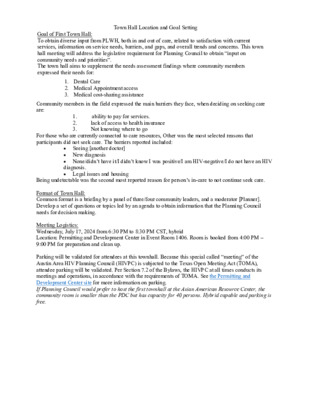
Town Hall Location and Goal Setting Goal of First Town Hall: To obtain diverse input from PLWH, both in and out of care, related to satisfaction with current services, information on service needs, barriers, and gaps, and overall trends and concerns. This town hall meeting will address the legislative requirement for Planning Council to obtain “input on community needs and priorities”. The town hall aims to supplement the needs assessment findings where community members expressed their needs for: Community members in the field expressed the main barriers they face, when deciding on seeking care are: 1. Dental Care 2. Medical Appointment access 3. Medical cost-sharing assistance 1. 2. 3. ability to pay for services. lack of access to health insurance Not knowing where to go For those who are currently connected to care resources, Other was the most selected reasons that participants did not seek care. The barriers reported included: Seeing [another doctor] • • New diagnosis • None/didn’t have it/I didn’t know I was positive/I am HIV-negative/I do not have an HIV diagnosis. • Legal issues and housing Being undetectable was the second most reported reason for person’s in-care to not continue seek care. Format of Town Hall: Common format is a briefing by a panel of three/four community leaders, and a moderator [Planner]. Develop a set of questions or topics led by an agenda to obtain information that the Planning Council needs for decision making. Meeting Logistics: Wednesday, July 17, 2024 from 6:30 PM to 8:30 PM CST, hybrid Location: Permitting and Development Center in Event Room 1406. Room is booked from 4:00 PM – 9:00 PM for preparation and clean up. Parking will be validated for attendees at this townhall. Because this special called “meeting” of the Austin Area HIV Planning Council (HIVPC) is subjected to the Texas Open Meeting Act (TOMA), attendee parking will be validated. Per Section 7.2 of the Bylaws, the HIVPC at all times conducts its meetings and operations, in accordance with the requirements of TOMA. See the Permitting and Development Center site for more information on parking. If Planning Council would prefer to host the first townhall at the Asian American Resource Center, the community room is smaller than the PDC but has capacity for 40 persons. Hybrid capable and parking is free. Regarding Townhall #2, based on previous related discussions with the Chair and council, the Planner has posed the idea …
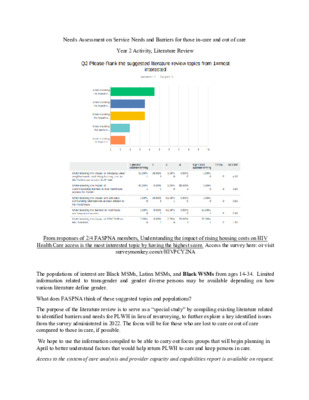
Needs Assessment on Service Needs and Barriers for those in-care and out of care Year 2 Activity, Literature Review From responses of 2/4 FASPNA members, Understanding the impact of rising housing costs on HIV Health Care access is the most interested topic by having the highest score. Access the survey here: or visit surveymonkey.com/r/HIVPCY2NA The populations of interest are Black MSMs, Latinx MSMs, and Black WSMs from ages 14-34. Limited information related to transgender and gender diverse persons may be available depending on how various literature define gender. What does FASPNA think of these suggested topics and populations? The purpose of the literature review is to serve as a “special study” by compiling existing literature related to identified barriers and needs for PLWH in lieu of resurveying, to further explore a key identified issues from the survey administered in 2022. The focus will be for those who are lost to care or out of care compared to those in care, if possible. We hope to use the information compiled to be able to carry out focus groups that will begin planning in April to better understand factors that would help return PLWH to care and keep persons in care. Access to the system of care analysis and provider capacity and capabilities report is available on request.
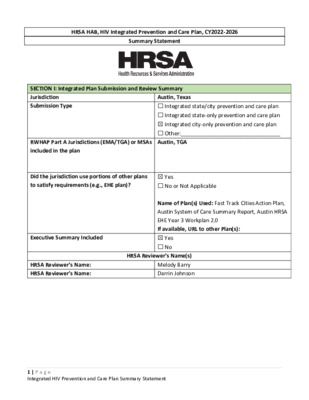
HRSA HAB, HIV Integrated Prevention and Care Plan, CY2022-2026 Summary Statement SECTION I: Integrated Plan Submission and Review Summary Jurisdiction Submission Type Austin, Texas ☐ Integrated state/city prevention and care plan ☐ Integrated state-only prevention and care plan ☒ Integrated city-only prevention and care plan ☐ Other:_________________________________ Austin, TGA ☒ Yes ☐ No or Not Applicable Name of Plan(s) Used: Fast Track Cities Action Plan, Austin System of Care Summary Report, Austin HRSA EHE Year 3 Workplan 2.0 If available, URL to other Plan(s): ☒ Yes ☐ No RWHAP Part A Jurisdictions (EMA/TGA) or MSAs included in the plan Did the jurisdiction use portions of other plans to satisfy requirements (e.g., EHE plan)? Executive Summary Included HRSA Reviewer’s Name: HRSA Reviewer’s Name: HRSA Reviewer’s Name(s) Melody Barry Darrin Johnson 1 | P a g e Integrated HIV Prevention and Care Plan Summary Statement SECTION II: Community Engagement and Planning Process Purpose of this Section: For the recipient to describe how the jurisdiction approached the planning process, engaged community members and stakeholders, and fulfilled legislative and programmatic requirements including: 1. SCSN 2. RWHAP Part A and B planning requirements including those requiring feedback from key stakeholders and people with HIV 3. CDC planning requirements Tips given to recipients for meeting this requirement: 1. This requirement may include submission of portions of other submitted plans including the EHE plan submitted as a deliverable for PS19-1906. 2. Be sure to provide adequate detail to confirm compliance with legislative and programmatic planning requirements. 3. The planning process should include key stakeholders and broad-based communities that include but are not limited to people with HIV, funded-service providers, and stakeholders, especially new stakeholders, from disproportionately affected communities. See Appendix 3 for required and suggested examples of stakeholders to be included. 4. Explain how the jurisdiction built collaborations among systems of care relevant to HIV in the jurisdictions (e.g., behavioral health and housing services). 5. Include community engagement related to “Respond” and support of cluster detection activities. Please select all planning bodies that participated in developing the Integrated Plan ☐ Integrated HIV Prevention and Care Planning Body ☒ RWHAP Part A Planning Council/Planning Body ☐ RWHAP Part B Advisory Group ☒ HIV Prevention Group (HPG) ☐ EHE Planning Body ☐ Other, please specify: Please note the remainder of this table includes the language provided to the recipient in the CY 2022-2026 CDC DHAP and HRSA HAB Integrated …

Austin Transitional Grant Area (TGA) Administrative Agent (AA) Report to HIV Planning Council May 2024 PART A & MAI GRANTS ADMINISTRATION/MANAGEMENT UPDATE HRA is now fully staffed. 1. 2. All RWA contracts have been fully executed or are being routed for signature. OTHER HIV RESOURCES ADMINISTRATION GRANT UPDATES 1. HOPWA: all contracts executed 2. Part C: all contracts executed 3. EHE PS20: 2-month extension being contracted 4. Part A/MAI: All FFY24-25 contracts are routing or executed 5. HRSA EHE: All FFY24-25 contracts are under negotiation PART A & MAI FISCAL UPDATE 1. Expenditures Through March 2024 CATEGORY Part A Formula MAI TOTAL Budgeted Amount Expended Amount Percent Expended $1,504,902 $20,647 1.37% $112,467 $522 0.46% $1,617,369 $21,169 1.31% • Budgeted amounts only reflect first Notice of Award. • As of 5/15/24 we have not received the final Notice of Award for FFY24. CLINICAL QUALITY MANAGEMENT 1. CQM Plan Development and Next Steps: The CQM plan is currently being revised to include EHE and Part C activities, monitoring and evaluation. HRA team will meet with HRSA to review CQM Plan prior to finalization on 5/16/24. CQM plan was presented to the CQM Committee on 5/09/24. 2. CQM Performance Measures: CQM performance measures for Part A/MAI, Part C and EHE have been drafted and shared with the CQM Committee. Performance measures will be finalized after review from the HRSA TA on 5/16/24. Austin TGA Administrative Agent Report to HIV Planning Council, January 2024, Page 1 3. Quality Improvement Project: Recipients have begun new round of quality improvement projects that will be focused on data quality and improvement in viral load suppression. This will be a six-month PDSA cycle ending in December 2024Recipients have begun new round of quality improvement projects that will be focused on data quality and improvement in viral load suppression. This will be a six-month PDSA cycle ending in December 2024. 4. CQM Committee Meetings: Last meeting was held on May 9, 2024, where subrecipients presented their findings on their last QIP Cycle. CQM Committee meetings will be moving from a monthly basis to a quarterly basis. CQM staff will begin meeting with the subrecipients on a monthly basis individually to provide individualized technical assistance in June. Data Management: TCT Enhancements and Issues: DATA MANAGEMENT UPDATE 1. The data staff at HRA continue to work through TCT issues with subrecipients and the TCT Help Desk. HRA meets with the TCT …

AUSTIN AREA HIV PLANNING COUNCIL The mission of the HIV Planning Council is to develop and coordinate an effective and comprehensive community-wide response to HIV. Planning Council: Office of Support Staff Report May 20, 2024 Business Committee Meeting OFFICE OF SUPPORT STAFF Kodjo Dodo, Manager Kodjo.Dodo@austintexas.gov Rashana Raggs, Supervisor Rashana.Raggs@austintexas.gov Nathalia Delgadillo, Planner II Nathalia.Delgadillo@austintexas.gov Zaria Thomas, Planner I Zaria.Thomas@austintexas.gov. Deena Rawleigh, Admin Sr. Deena.Rawleigh@austintexas.gov AUSTIN AREA HIV PLANNING COUNCIL MEMBERS TOTAL 10 (9 Voting, 1 Non-voting member) 1. Kelle’ Martin, Chair 2. Alicia Alston 3. Joe Anderson Jr. 4. Liza Bailey 5. Aran Belani 6. Zachery Garay 7. Ashley Garling 8. Marquis Goodwin 9. Judith Hassan 10. Rocky Lane, Non-Voting 11. Kristina McRae-Thompson 12. Gin Pham Summary The Austin Area HIV Planning Council (HIVPC) is at 12 members. The Executive Committee is expected to finish reviewing and updating the Policies and Procedures at their June meeting. The Governance/Membership/Care Strategies committee finalized date, time, location, and goals for the July 17, 2024 Townhall for people living with HIV at the Permitting and Development Center. They also working on recruitment and retention related items. The Finance/Allocations and Strategic Planning/Needs Assessment committee reviewed and updated their draft Summary of data needs and request for Priority Setting/Resource Allocation of FY25. The committee received a presentation on Minority AIDS Initiative (MAI) and Early Identification of Individuals with HIV/AIDS (EIIHA) to assist in determining their priority groups for FY25.This committee is continuing their updates to the Integrated Plan. The April Business committee received their annual PSRA training for FY25 and received a nomination The Fast Track Cities Consortium will be on May 30th. Get your Eventbrite tickets here. See more info in the for Vice Chair from Marquis Goodwin Outreach portion of the report. Event Requests Form https://www.surveymonkey.com/r/HIVPCEvents HIV PLANNING COUNCIL COMMITTEE UPDATES Executive Committee is seeking nominations for Secretary. Per the bylaws, nominations must be made during a business meeting. o The Executive Committee would like to bring back the Bylaws and Memorandum of Understanding for their June meeting for alignment and finish updating Policies and Procedures. Governance/Membership combined Care Strategies Committee (GMCS) committee chair is Zachery Garay. o The GMCS committee reviewed and approved the updates to the Recruitment and Retention brochure document. The committee would like to further discuss a Frequently Asked Questions document and a Linktree to assist council in their recruitment efforts …